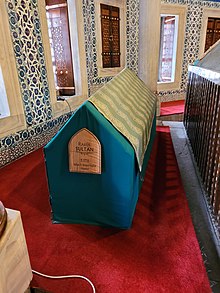| Rabia Sultan | |||||
|---|---|---|---|---|---|
 Sarcophagus of Rabia Sultan, Suleimaniye Mosque Sarcophagus of Rabia Sultan, Suleimaniye Mosque | |||||
| Haseki Sultan of the Ottoman Empire (Imperial Consort) | |||||
| Tenure | 11 November 1692 – 6 February 1695 | ||||
| Predecessor | Emetullah Rabia Gülnuş Sultan | ||||
| Successor | title abolished | ||||
| Born | c. 1670 | ||||
| Died | 12 January 1712(1712-01-12) (aged 41–42) Old Palace, Beyazıt Square, Constantinople, Ottoman Empire | ||||
| Burial | Suleiman the Magnificent Mausoleum, Süleymaniye Mosque, Istanbul | ||||
| Consort of | Ahmed II | ||||
| Issue |
| ||||
| |||||
| House | House of Osman | ||||
| Religion | Sunni Islam (converted) | ||||
Rabia Sultan (Turkish pronunciation: [ɾabiˀa suɫtʰan]; Ottoman Turkish: رابعه سلطان, "spring"; died 14 January 1712) was the Haseki Sultan of Sultan Ahmed II of the Ottoman Empire. She was the last woman to have the Haseki title.
As imperial consort
Her origin is unknown, but the consorts of the Ottoman sultans were by custom normally concubines who came to the Ottoman imperial harem via the Ottoman slave trade.
Since Muazzez Sultan, the mother of Sultan Ahmed, had died in 1687 before his accession to the throne in 1691, when Rabia became Ahmed's favorite she assumed the position of the highest-ranking female member of the royal family, with the title of "Senior Consort".
On 6 October 1692, she gave birth to twin sons, Şehzade Ibrahim and Şehzade Selim, in the Edirne Palace. Following their birth, Ahmed presented her the mansion of Bayburtlu Kara Ibrahim Pasha located in Kuzguncuk. Şehzade Selim died in May 1693.
On 11 November 1692, she was given the title of "Haseki Sultan". Rabia was the last woman in history to have this title: after Ahmed II's death, the main consorts of subsequent sultans were titled Kadın, a nonexclusive and less prestigious title. Kara Mustafa Pasha, who had been executed in 1683, had left a large amount of assets that had been placed in the imperial treasury. In December 1692, diamond froggings from these assets ended up on Rabia's fur coat. She also received a diamond crown from the same assets.
In January 1694, Rabia attended the wedding of Ümmügülsüm Sultan, daughter of Mehmed IV, and Silahdar Çerkes Osman Pasha. On 23 October 1694, she gave birth to her third child and only daughter, Asiye Sultan. Following her birth, Ahmed granted her lands in Aleppo.
Gevherhan Sultan, daughter of Sultan Ibrahim, and Rabia's sister-in-law, is understood to have been in great debt, according to Topkapı Palace archives dating 28 November 1694, a substantial amount of which was owed to Rabia.
Some of the debts mentioned were covered by the allocation of Gevherhan's grants from her hass, that is revenue-producing estates to Asiye Sultan, the infant daughter of Ahmed and Rabia, as shown in archives dating 1 December 1694.
Widowhood and death
Rabia was widowed following Ahmed's death in February 1695. On 7 March, her son Şehzade Ibrahim, was put in the care of Valide Sultan Gülnuş, whereas she and her daughter Asiye were sent to the Old Palace in Istanbul, where Asiye died in December 1695.
Rabia Sultan died on 14 January 1712 in the Old Palace, and was buried beside Ahmed II in the mausoleum of Suleiman the Magnificent, Süleymaniye Mosque, Istanbul.
Her son, Şehzade Ibrahim, who became heir apparent in 1703, after Sultan Ahmed III's accession to the throne, outlived her by two years, dying in 1714.
Issue

Together with Ahmed, Rabia had three children, two twins sons and a daughter:
- Şehzade Ibrahim (Edirne Palace, Edirne, 6 October 1692 – Topkapı Palace, Istanbul, 4 May 1714, buried in Mustafa I Mausoleum, Hagia Sophia), twin of Selim, became Crown Prince on 22 August 1703;
- Şehzade Selim (Edirne Palace, Edirne, 6 October 1692 – Edirne Palace, Edirne, 15 May 1693, buried in Sultan Mustafa Mausoleum, Hagia Sophia), twin of Ibrahim;
- Asiye Sultan (Edirne Palace, Edirne, 24 August 1694 – Old Palace, Costantinople, 9 December 1695, buried with her parents in Suleiman I Mausoleum, Süleymaniye Mosque);
See also
References
- ^ Uluçay 2011, p. 114.
- Peirce, Leslie (1993). The Imperial Harem: Women and Sovereignty in the Ottoman Empire. Oxford: Oxford University Press. ISBN 0-19-508677-5.
- Uluçay 2011, p. 97.
- Earthly Delights. BRILL. June 14, 2018. p. 60. ISBN 978-9-004-36754-8.
- Publications de la Société d'histoire turque: VIII. sér. Türk Tarih Kurumu Basımevı. 1945. p. 152.
- Agha 2012, p. 1466.
- Sakaoğlu 2008, p. 390.
- Agha 2012, p. 1483.
- Agha 2012, p. 1470.
- Akçetin, Elif; Faroqhi, Suraiya (October 20, 2017). Living the Good Life: Consumption in the Qing and Ottoman Empires of the Eighteenth Century. BRILL. pp. 410–411. ISBN 978-9-004-35345-9.
- Agha 2012, p. 1527-28.
- ^ Uluçay 2011, p. 115.
- Sakaoğlu 2008, p. 391.
- ^ Osmanlıoğlu 2018, p. 55.
- Uluçay 2011, p. 103.
- Sakaoğlu 2008, p. 260.
- Majer, Hans Georg (1992). Osmanlı Araştırmaları XII (The Journal of Ottoman Studies XII): The harem of Mustafa II (1695-1703). p. 432.
- Agha 2001, p. 114.
- Sakaoğlu 2008, p. 390-1.
- Agha 2001, p. 763.
- Oztüna, Yılmaz (1990). Büyük Türk mûsikîsi ansiklopedisi, Volume 1. Kültür Bakanlığı. p. 30. ISBN 978-9-751-70666-9.
Sources
- Agha, Silahdar Findiklili Mehmed (2012). ZEYL-İ FEZLEKE (1065-22 Ca.1106 / 1654-7 Şubat 1695).
- Agha, Silahdar Findiklili Mehmed (2001). Nusretnâme: Tahlil ve Metin (1106-1133/1695-1721).
- Osmanlıoğlu, Sekan (2018). "Kuzguncuk Asiye Sultan ve Haseki Rabia Sultan Yalıları". Uluslarasi Üsküdar Sempozyumu, no. X.
- Sakaoğlu, Necdet (2008). Bu mülkün kadın sultanları: Vâlide sultanlar, hâtunlar, hasekiler, kadınefendiler, sultanefendiler. Oğlak Yayıncılık. ISBN 978-9-753-29623-6.
- Uluçay, Mustafa Çağatay (2011). Padişahların kadınları ve kızları. Ankara, Ötüken.
| Ottoman royalty | ||
|---|---|---|
| Preceded byGülnuş Sultan | Haseki Sultan 11 November 1692 – 6 February 1695 |
None Title abolished |
